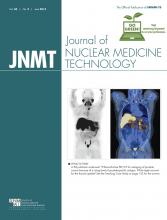Norman E. Bolus, MSPH, MPH, CNMT, FSNMMI-TS
How many times have you had to answer the question “What is nuclear medicine?” from family, friends, patients, fellow health care providers, and others? I am amazed at how often I have had to explain it or when someone, after having known me for decades, looks at me seriously and says, “Now what exactly is it that you do and what is nuclear medicine?” Because I am so often asked this seemingly ubiquitous question, I have come up with a standard response that you may or may not agree is appropriate. Feel free to use the following explanation if you like it, even though it may not be totally correct.
“Nuclear medicine is a specialty of radiology like CT, MR imaging, and ultrasound that is an offshoot of the Manhattan Project at the end of World War II. Scientists wanted a peaceful use of radioactivity, and the field of nuclear medicine began at that time. Have you ever had a dental x-ray or chest x-ray? Well, nuclear medicine is the opposite of an x-ray. X-rays are produced by a machine and pass through the body and onto a film or digital screen; a shadow is cast on the film showing which x-rays do and do not get through the body. This shadow is actually showing densities in the body and how easily the x-rays pass through body structures of different densities.
“In nuclear medicine, we use small amounts of radioactivity, called gamma rays. Once they are in the body we can see and track them using a highly specialized radiation detector, a gamma camera. The gamma camera is not producing the gamma rays, it is merely detecting and making images of the gamma rays that are coming from the patient. And the main way we get these gamma rays into the patient’s body is by attaching them to a drug and injecting it intravenously. We call these radiopharmaceuticals. They travel through the bloodstream to a specific organ—for example, the kidney. The kidney will then metabolize the radiopharmaceutical and produce urine, which we can track as it is eliminated into the bladder. As such, we can see how the body functions and we can visualize its physiology. Likewise, we can do this to study the heart. By seeing how well the heart is taking up our radiopharmaceutical, we can determine whether a coronary artery is blocked. This type of heart study is very common and is used primarily as a screening tool to determine whether someone needs to have an angiogram or a heart catheterization.
“We have over 100 different types of procedures in nuclear medicine that will allow us to tag a radioactive element to a drug so we can “see” different organs or functions in the body. Another study we have is to spike an egg sandwich with radioactivity and have the patient eat it. We can then track the sandwich as it travels through the body and see if there are any blockages in the digestive tract. We can even determine how long it takes the sandwich to pass through the digestive tract. Nuclear medicine is also used to treat some kinds of cancer, but nuclear medicine therapy is not the same as radiation therapy, which is a different field. The difference between radiation therapy and nuclear medicine therapy is that radiation therapy uses either a machine that produces ionizing radiation or a sealed source. If the therapy involves a liquid source, or a semiliquid source such as nanoparticles, then it falls under the realm of nuclear medicine because we are used to working with sources that can cause radiation contamination outside the body.”
If my listener is not too glazed over at this point, I continue: “Have you ever heard of PET imaging? PET stands for positron emission tomography. Positrons are actually antimatter, a positive electron, which cannot exist in nature. As soon as a positron comes into contact with an electron, something called an annihilation event occurs—the positron is blown apart, producing two gamma rays that fly away from each at a 180-degree angle. PET imaging is a type of a nuclear medicine exam because our gamma cameras can detect these gamma rays.”
Or, when people ask you what nuclear medicine is, perhaps it may be easier simply to quote the dictionary to them:“Nuclear medicine (noun): a branch of medicine dealing with the use of radioactive materials in the diagnosis and treatment of disease. First known use of NUCLEAR MEDICINE: 1952.”
—Merriam-Webster Collegiate Dictionary
In this issue of JNMT we have two original continuing education offerings, one on patient preparation for 123I-MIBG imaging and the other on the relatively new agent 99mTc-tilmanocept. We have a student perspective on gathering data for a research project, 5 teaching case studies, a variety of imaging articles, and a special contribution on publication productivity in nuclear medicine.
For the online conversation this quarter, I would simply like to ask how you respond when someone asks you what nuclear medicine is. Go to the SNMMI Facebook page at www.snmmi.org/facebook and add your comments.








